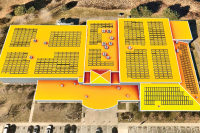March kicks off 2024 ozone season
March 1 marked the beginning of the 2024 ozone season as state and local environmental agencies renew their daily air quality forecasts for ozone across North Carolina.
No time to relax: Smokies air quality has improved, but a new ozone standard is on its way
 Breathing easy in the Smokies is a better bet than it’s been in decades. Ozone pollution is down 36 percent, and particle pollution has been cut in half. The mountain view on the haziest days now extends nearly four times as far as it did in 1998. Streams harmed by acid rain are starting to recover.
Breathing easy in the Smokies is a better bet than it’s been in decades. Ozone pollution is down 36 percent, and particle pollution has been cut in half. The mountain view on the haziest days now extends nearly four times as far as it did in 1998. Streams harmed by acid rain are starting to recover.
All stats that are cause for celebration, said a group of air quality leaders gathered on Purchase Knob in the Great Smoky Mountains National Park last week.
Lookin’ good up there: Ozone outlook positive for North Carolina
 Warmer weather is on its way, but along with the sunny afternoons comes the return of ozone season. A bad forecast can cancel high elevations hiking trips and outdoor playdates, but North Carolina has been seeing a decrease in those high-risk days. In fact, summer 2013 was the lowest season on record, following a downward trend in ozone that’s held steady since 1999.
Warmer weather is on its way, but along with the sunny afternoons comes the return of ozone season. A bad forecast can cancel high elevations hiking trips and outdoor playdates, but North Carolina has been seeing a decrease in those high-risk days. In fact, summer 2013 was the lowest season on record, following a downward trend in ozone that’s held steady since 1999.
“In the environmental arena, you don’t always see those kinds of results, so it’s very rewarding for those of us who have worked on these issues to see those results,” said Bill Eaker, environmental planner for the Land of Sky Regional Council. “But we still have a lot to do.”
EPA ozone standards
Limit prior to 2008: .08 parts per million
New limit set in 2008: .075 parts per million
New limit pending in 2010: Between .06 and .07 parts per million
How WNC stacks up
Ozone levels have improved gradually in WNC over the past 10 years. They can vary widely from year to year depending on weather, however. Wetter and cooler summers see fewer bad ozone days that hotter, drier ones.
To determine whether WNC meets the new ozone limits, an average of three years worth of ozone readings — from 2008 through 2010 — will be used.
Here’s the levels for ozone monitoring stations in the region based on the three-year average from 2007-2009. Ozone is worse at higher elevations and surprisingly consistant across the mountains.
Waynesville .068 parts per million
Bryson City .064 parts per million
Asheville .069 parts per million
High elevation sites
Purchase Knob .074 parts per million
(near Hemphill Knob above Jonathan Creek in Haywood County)
Frying Pan .074 parts per million
(near Mount Pisgah off the Blue Ridge Parkway in Haywood County)
Mount Mitchell .074 parts per million
(highest elevation on the east coast)
• A monitoring station has been recently installed on Barnet Knob on Cherokee Indian Reservation and will be providing data this year.
New standards to shine light on WNC air quality
New federal standards for ozone will be issued by year’s end, and the verdict will determine whether Western North Carolina is out of compliance with air quality.
Western North Carolina likely can’t fix its air quality problem alone. Charlotte, Knoxville and Atlanta are all out of compliance under current ozone limits, let alone the more rigorous ones that are pending. Smog is carried from these metropolitan areas into the mountains.
In addition, antiquated, dirty coal plants operated by Tennessee Valley Authority from Ohio to Tennessee to Alabama send pollution this way.
“Is there enough we could do in North Carolina to achieve the standards?” asked Paul Muller, regional supervisor for the N.C. Division of Air Quality in Asheville.
Probably not, he said. But since WNC won’t be alone in its violation of ozone standards, a multi-state approach will be inevitable.
“Knoxville has a problem. Atlanta has a problem. So they are going to have to be making reductions as well,” Muller said.
Ozone levels have declined over the past decade, proving that tailpipe regulations and new emissions standards gradually being imposed on coal plants can work, according to Muller.
“How do we keep getting cleaner so we can meet the tighter standards?” Muller said. “In a lot of ways we depend on the federal government to put in reduction programs that will affect a larger area.”
But attempts to impose tougher pollution limits on coal plants have met resistance in court. The benefits that would otherwise be realized by new regulations are taking longer, Muller said.
While it is easy to point fingers at dirty coal plants or wafting smog from urban centers, it will ultimately take everyone working together to improve air quality — including steps by everyone living in the region.
“Air quality is impacting our health our environment and our economy,” said Bill Eaker, environmental specialist with Land of the Sky Regional Council. “We are going to have to take action to reduce energy consumption and reduce fuel use for our cars and vehicles.”
Ozone, which is the main ingredient in smog, is worse in the summer. The Land of the Sky Regional Council hosted an ozone season press conference last week, as it does every year at the outset of the ozone season. Speakers at the event educate the press on the latest air pollution rules, tout success stories and share various initiatives underway throughout the region to improve air quality.
Limit in flux
An ozone standard is set by the Environmental Protection Agency every five years. New limits came out in 2008, but have been in flux ever since, due both to lawsuits and a shift in policy from the Bush to Obama administration.
When reviewing the ozone standard, the EPA relies on a panel of scientists to recommend a safe limit both for human health and the environment. But in 2008, the EPA bucked the scientists and instead settled on a slightly laxer number.
“This was a big deal because EPA usually takes the advice of its science committee,” according to Vicki Sandiford, an air quality specialist with the EPA in Raleigh. “The law requires EPA to explain in a rational way why it chose not to follow the recommendation of its science advisers.”
Apparently, the explanation was lacking, since lawsuits by environmental groups promptly followed. The scientists on the panel even weighed in expressing anger that their advice was not followed.
When Obama took office, he appointed a new EPA director, and a policy shift followed suit.
“It is the goal of this administration to have science in the forefront of the regulations it considers,” Sandiford said.
So it was back to the drawing board. The new ozone standards will be announced by August (see box).
There are 1,200 ozone monitors in the United States, mostly in urban areas. The EPA wants to see 270 new monitors installed throughout the country.
With many areas in violation of the old ozone limits, it is unclear how quickly even tougher limits will be complied with. Charlotte has been in violation of federal ozone standards since 1997. Why such a long leash to meet the standards?
“Partly because of the difficulty for many areas in meeting the standard,” Sandiford said. “They want to give area time to put programs in place and see the results it keeps it from being so burdensome.”
Ozone forecast
To get your ozone forecast, go to ncair.org. Click on “air quality forecast.”





